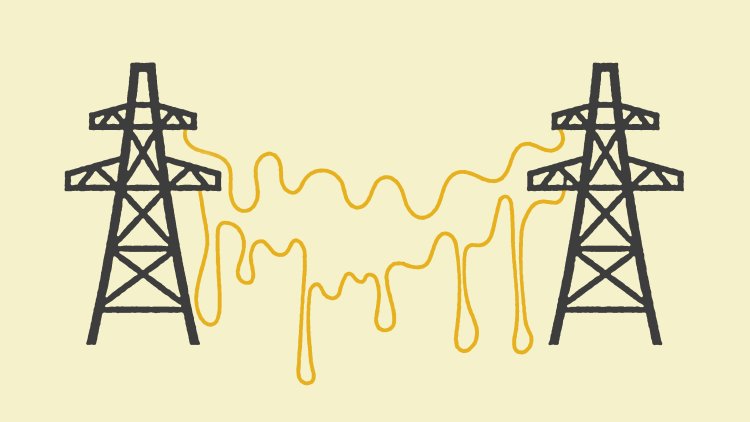America Has a Hot-Steel Problem
Railways, roads, power lines, batteries—the heat of climate change is making them all falter.

A basic fact of thermodynamics is coming to haunt every foot of train track in the United States. Heat makes steel expand, moving its molecules farther apart, and as hot days become hotter and more frequent, rail lines are at risk of warping and buckling more often.
Any fix must deal with this fundamental truth of physics. Railroads can slow their trains down, which avoids adding more heat. Or they can leave gaps in a rail (or cut them as an emergency measure), which relieves pressure that causes track to bulge but means a potentially bumpier and slower ride. Painting tracks white would help deflect heat, but the paint would need to be reapplied frequently. Adapting to this reality will be expensive, and might ultimately just look as it does now: slow the trains, cut the track, issue a delay.
Our infrastructure is simply becoming too hot to function, or at least function well. High heat can also cause bridges to fail, for the same reason as with train tracks. Roads can buckle, thanks to the thermodynamics of concrete and asphalt. In Alaska, where permafrost is thawing into a substrate more akin to a waterbed, roads can resemble an undulating line of ribbon candy. Heat has two effects on power transmission, and “both of them are bad,” Bilal Ayyub, a civil-engineering professor at the University of Maryland, told me. One, heat reduces how much electricity power lines can deliver. Two, heat increases demand—everyone turns on their air conditioners in unison—further straining an already heat-strained grid, sometimes to its breaking point. (And those air conditioners need more power to run, because they’re also less efficient in high temperatures.) Phone and car batteries drain more easily when heat speeds up their internal chemical reactions.
According to the U.S. Census Bureau, this country currently builds more than $2 trillion worth of new construction a year. Each piece of it might have a life span of 50 to 100 years, Ayyub said. What we build now will face circumstances the world of modern infrastructure has never seen. To keep up, engineers need to start designing for it now.
One obvious way forward would be to incorporate climate projections into building codes. Each time an engineer designs a piece of infrastructure, it must meet certain local codes meant to guard against the daily pressures of gravity and the vagaries of regional weather—ranges determined, until now, by looking at historical records. These codes are based on standards written by organizations including the American Society of Civil Engineers (ASCE) through a painstaking consensus process; incorporating the risks of rising heat counts as cutting-edge in this slow-moving world.
Right now, ASCE is in the midst of a six-year push to have building codes take future climate change into account, using research from the National Oceanic and Atmospheric Administration. (Ayyub, who helped incorporate flood risk into New Orleans’s post-Katrina reconstruction plan, is part of that process.) But these codes are only recommendations; state and local governments decide whether to adopt them. And that choice can come down to political stances on climate change, in Ayyub’s experience.
But building codes represent the bare-minimum level of safety and stability that a designer must adhere to. Another way to keep up with unprecedented changes is to build beyond that, in a way that embraces uncertainty and factors in failure, according to Mikhail Chester, the director of the Metis Center for Infrastructure and Sustainable Engineering at Arizona State University. Rather than assuming that systems built to withstand historical conditions are fail-safe, engineers and planners should focus on making them safe to fail, finding opportunities to minimize human harm. Power failures may be inevitable during a heat wave, but creating ancillary systems—such as community cooling centers and shade structures—can save lives in that situation.
Chester told me he has no doubt that engineers could design infrastructure to stand up to rising temperatures. To him, “the question is, at what cost?” Trying to “harden, strengthen, and armor” every piece of existing infrastructure to withstand climate hazards, including excessive heat, is economically impractical—and likely impossible. “You can’t reengineer all of U.S. infrastructure as quickly as the climate is changing,” Chester said.
The key, instead, will be to do triage. Some places need more attention than others: Chester pointed out that a newer city like Phoenix, where he lives, is actually more closely designed to withstand current conditions than a place like New York City, where many designs are based on older extremes. And some systems demand precedence: Water infrastructure and transportation systems are critical to life, for instance, but power systems supply them both. So designing resilient power systems ought to come first. But “the solution for it is costly,” Ayyub said. It involves building more energy-storage capacity, updating a nation’s worth of transmission lines (not to mention major permitting reform), and probably having a metering system in place to modulate how much power each user can access. “But it does require the users to agree to that,” he added, and it may be a hard sell.
For now, the upward trajectory of heat is outpacing all construction ambitions, and forcing decisions about how best to balance affordability and risk. Energy is the biggest infrastructure challenge that both Ayyub and Chester foresee, but when it comes to things like train lines and other forms of built infrastructure, they’re both hopeful that humanity will design ways to work around the heat. Humans are good at building things when they need to. But it’s far easier for humans to fix their own machines than to fix large-scale biological systems; those are critical systems Ayyub is worried about more. Mass biodiversity loss concerns him first—that’s unrecoverable once it’s gone—along with food security and agriculture. Engineering can get us only so far.
What's Your Reaction?




















